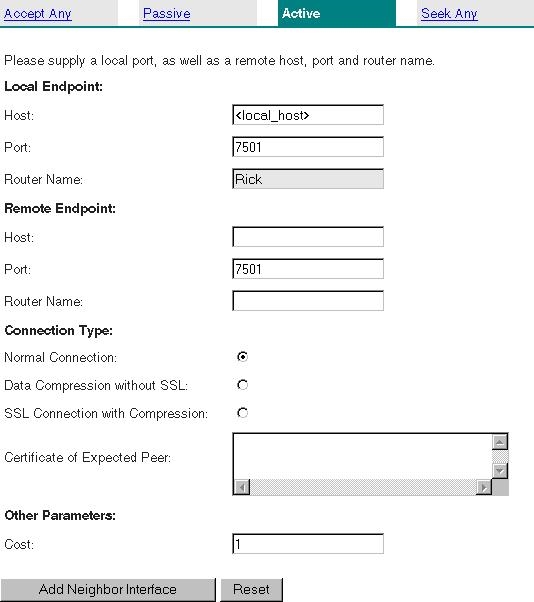Add New Neighbor Interface
The remainder of this page lets you complete a form to specify a new neighbor interface.
Figure 110: rvrd Neighbor Interface Configuration Form
Four Variations of the Form
Four buttons rearrange the form into four variations, each with a different meaning. In each variation, rvrd automatically fills in some fields, and leaves others empty for you to fill.
|
Item |
Description |
|||||||||
|
Accept Any |
Use this variation of the form to specify a neighbor interface in which this routing daemon accepts neighbor connections from any other routing daemon. A distinguishing characteristic of accept any neighbors is a remote endpoint string in which the router name, the host and the port are all Any. Restrictions:
For more information, see Accept Any as Neighbor. |
|||||||||
|
Passive |
Use this variation of the form to specify a neighbor interface in which the local router does not actively attempt to connect to the remote neighbor. Instead, it passively waits for the remote neighbor to request a connection. A distinguishing characteristic of passive neighbors is a remote endpoint string in which the router name is specified, but the host and port are Any. For more information, see Passive Neighbor. |
|||||||||
|
Active |
Use this variation of the form to specify a neighbor interface in which the local router actively attempts to connect to the remote neighbor. A distinguishing characteristic of active neighbors is a remote endpoint string in which the router name, the host and the port are all specified. For an example, see Active Neighbor. |
|||||||||
|
Seek Any |
Use this variation of the form to specify a neighbor interface in which this routing daemon attempts to connect to any remote routing daemon that matches the specification. A distinguishing characteristic of seek any neighbors is a remote endpoint string in which the router name is Any, but the host and the port are specified. In addition, the local endpoint port is Any. Restrictions:
For more information, see Seek Neighbor with Any Name. |
Items in the Neighbor Interface Configuration Form
This table describes the items in rvrd Neighbor Interface Configuration Form.
|
Item |
Description |
|||||||||
|
Local Endpoint |
This three-part specification denotes the local end of the potential neighbor link:
|
|||||||||
|
Remote Endpoint |
This three-part specification denotes the remote end of the potential neighbor link:
For more information, see Remote Connection Information. |
|||||||||
|
Normal Connection |
With this option, the two neighbors neither compress data nor use TLS protocols for communication on the link between them. |
|||||||||
|
Data Compression without SSL |
With this option, the two neighbors compress data on the link between them. To enable compression, you must select this option on both neighbors. For more information, see Data Compression. |
|||||||||
|
With this option, the two neighbors communicate using both compression and TLS protocols. To enable TLS, you must select this option on both neighbors—otherwise they cannot establish a connection. This option appears only in the Passive and Active variations of the configuration form. Connection statistics are not available when neighbors connect using TLS. In older releases of the routing daemon, TLS and compression are mutually exclusive features. For backward compatibility with older neighbors, this feature degrades gracefully to TLS without compression. |
||||||||||
|
Certificate of Expected Peer |
In TLS protocols, the local router expects the remote router to present this certificate as evidence of its identity. Paste the text of the public certificate (in PEM encoding) in this field. This field appears only in the Passive and Active variations of the configuration form. |
|||||||||
|
Cost |
The path cost of this neighbor link (see Load Balancing). |
